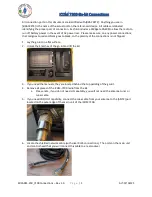
Installation and Setup
51
Instruction Manual – DXLink Fiber Transmitters and Receivers
Audio Type Precedence
The connectors for bringing audio into the system on the Transmitters are as follows:
HDMI In connector – Embedded audio signal
Digital Audio In jack – Digital audio signal (S/PDIF)
Stereo Audio In jack – Analog stereo audio signal
The hierarchy for audio type precedence* is listed in the following table for the Transmitters:
* Audio precedence as specified in the table above is applicable when the AUDIN_FORMAT_AUTO command is set to
ENABLE; this precedence can be overridden by SEND_COMMANDs (see page 87).
The audio selected by the Transmitter is embedded on the HDMI signal (if not already embedded) and sent to the
switcher or directly to the RX via the fiber optic cable.
The DXLink Fiber RX will by default take the embedded audio it receives from a Transmitter** and output the
following types of audio:
HDMI Out connector – Embedded digital audio signal
Stereo Audio Out connector – Analog stereo audio signal
The audio output can be changed using the AUDOUT_FORMAT command (see page 81).
** These exceptions apply: In order for audio to be sent out of the analog stereo audio connector on the DXLink Fiber
RX, it must have originated or be embedded in the HDMI signal on the Enova DGX Digital Media Switcher or DXLink
Fiber Transmitter as a 2 channel signal (either analog stereo or 2 channel L-PCM). Multi-channel (>2 channel) L-PCM
formats will pass incomplete audio (only 2 of the multiple channels will be sent). All other audio formats will be muted
at the connector.
DXLink Fiber TX – Attaching Signal, Transport, and Control Cables
Important:
Before attaching cables, be sure to set the DIP switch’s toggles if necessary (see page 46).
Tips for Fiber Optic Connections:
Keep dust plugs in transceivers until you are ready to make a connection.
Clean fiber optic cable ends before attaching to unit (be sure to follow the cable manufacturer’s instructions
for inspecting and cleaning the cable ends).
Use gentle pressure when connecting fiber optic cables to transceivers (normally an audible click is heard
when the connector engages).
If unsure the connection is properly seated, gently tug on the connector.
If fiber optic cables are removed from the transceivers, reinsert dust plugs.
Multimode transceivers only
– If you are unsure that a multimode transceiver is passing a signal, hold the
unattached end of the fiber optic cable
away from you
and take a picture of it with a digital camera (or cell
phone camera). The image will show a bright light if the signal is being passed (works on some digital
cameras and cell phone cameras).
Note:
Power, IR, and RS-232 ports are covered in their own sections.
Audio Type Precedence on DXLink Fiber Transmitters
Incoming Signal
Audio Type Selected
HDMI w/ embedded digital audio
HDMI w/ embedded digital audio
S/PDIF digital audio only
S/PDIF digital audio
Stereo audio only
Stereo audio
S/PDIF digital audio and stereo audio
S/PDIF digital audio
HDMI w/ embedded digital audio and S/PDIF digital audio
HDMI w/ embedded digital audio
HDMI w/ embedded digital audio and stereo audio
HDMI w/ embedded digital audio
HDMI w/ embedded digital audio, S/PDIF digital audio, and stereo audio
HDMI w/ embedded digital audio
Warning:
DXLink Fiber units use laser transceivers, which are Class 1 Eye Safe per IEC 60825-1/CDRH
requirements. While the Class 1 category indicates that the invisible laser used is safe, we recommend
avoiding direct eye exposure when using any optical fiber products (see the OSHA directive on page 15).
















































